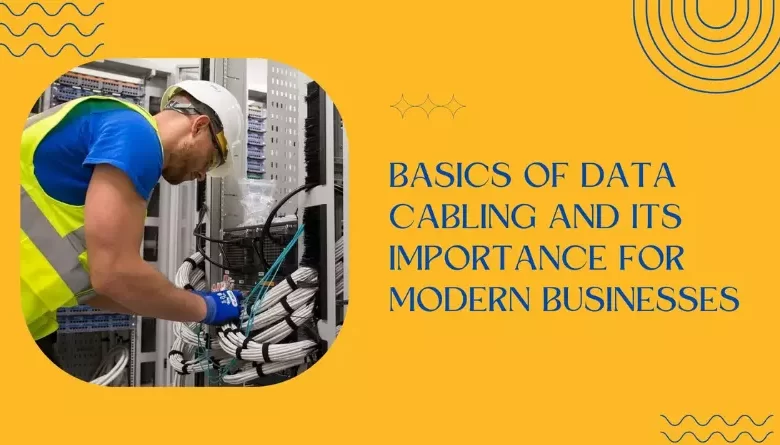Basics of data cabling and its importance for modern businesses

There are various types of network cables in the market A computer network cable is one of those kinds that are used for linking laptop or wifi devices to an internet network. Other than the internet it can also be used as a connector to other different types of computer networks. It will give you a clear understanding of this piece of technology. Thus you will better understand how important this item is in running your business smoothly. A network cable forms an essential component of any IT infrastructure. It is widely used both at home and in commercial and industrial premises. Your network cable must work smoothly. Otherwise, all your activities will crash down within a minute. Networks are crucial these days; a network runs so many things including computer systems, smart TV sets and literally everything that you can think in between. In the following sections of the blog post let bus explore few basic specs of network cable. It will provide you with proper information of this piece of technology. Thus, you will well recognize how important this piece is to run your business smoothly online.
What is a network cabling?
Two important facts about network cables are as follows –
- Network cabling is a physical, real-world infrastructure.
- It connects various devices including computers to a network.
Network cabling can be installed by any IT personnel. Alternatively, you may also contact a contractor to get the job done. It is not that important who is installing it but it must be fixed correctly. Data loss and downtime are the most common features of any poorly designed network. You have to prevent these issues at any cost to run your business efficiently and drive it to higher levels of success. To avoid those issues in your network you must ensure your network cables are installed correctly.
Network cabling – why is it important?
Network cables or data cables are the backbone of any network. The conduit allows the hardware engaged in a network to communicate with each other. It also acts as the medium in carrying data from one device to another. According to experts providing data cabling in London the infrastructure allows users to connect their network devices and thus they are enabled to share information or resources like printers, access to the Internet and others.
Network cabling forms an important part of any network. It is through network cabling that computers and devices connected to a network communicate with one another. In the absence of network data cables or network internet cables, it is nearly not possible for any device on a network to send or receive data through the medium. This is the actual reason why it is crucial to know the kind of cable you need to run your internet network. This is also the main reason to invest in top-grade cabling or upgrade the IT network for your business.
Different types of network cabling
Network cables can be broadly categorised into four varieties. These are coax cables, fibre optic cables, shielded twisted pair cables or STP and unshielded twisted pair cables or UTP. Let us now get into little details about each of these varieties.
Coaxial or coax cables
Coax cables are usually common in old buildings. It consists of a copper core covered by an insulating material and then a metal sheath. The metal sheath plays dual roles – it provides strength to the overall structure of the coax cable in one hand. While on the other keeps water, dirt and other unwanted elements away. Installation of coax cables is simple and easy. This is the reason why it is widely used in home networks. Coaxial cables are ideal to transmit data within short distances. So it is not ideal to use in commercial buildings.
Fibre optic cable
This variety of network cables was designed to replace coax cables. This can transmit data faster over longer distances. Compared to coax cables data loss in fibre optic cables is marginal and negligible. This variety of network cables consists of two thin pieces of plastic or glass. These pieces are called fibres and data is transmitted through the fibres. Data are transmitted through pulses of light in fibre optic cables, whereas in all other varieties of data cable data is transmitted through electricity.
Fibre optic cables provide lots of benefits including the following –
- Faster data transmission rate
- Greater bandwidth capacity
- Higher immunity from electromagnetic interference
- Longer distances between nodes (in UTP the distance is 10 metres while in fibre optic cables it is 100 metres)
According to trained and skilled professionals working in a leading data cabling company London fibre optic provides even more benefits than what has been mentioned above. It offers resistance from corrosion and fire damage too if the endpoints are properly sealed within a conduit that goes through the walls of a building. The conduit may even contain more pairs of fibre optic cables.
STP or shielded twisted pair cable
This is a combination of four sets of a single pair wire. Two pairs are meant for receiving signals while the other two are for transmitting signals. This type of data cable is widely used in telephone networks. It can withstand interference from radio waves, power lines and other sources. The type of cable is also used in computer networks. Shielded twisted pair cable can prevent interference of noise in signals. Thus it is capable to prevent signal disruption. Signal can be transmitted over long distances through it. STP mainly remains connected to servers and desktop computers inside buildings.
UTP or unshielded twisted pair cable
Unshielded pair cables are also known in the industry as UTP. The commonest use of this variety of network cabling is in telephone lines. The reasons are logical – it is cheaper than other varieties of network cabling. In addition, it is simpler to install compared to other cabling systems like coax or fibre optic cable. UTP or unshielded twisted pair cable also has its use in computer networks. The cable can easily run through ceilings and walls without the help of any additional tools or special equipment. UTP is composed of copper wires twisted around each other. Experts busy with network cabling in London explain this minimises interference from external sources that are likely to disrupt the transmission of data across long distances.
Benefits of network cabling
- In this age and time network cabling is the backbone of any business.
- Network cabling or data cables allow you to connect all your devices and computers with the rest of the world to share files and information.
In addition to that it offers loads of other benefits as well.





